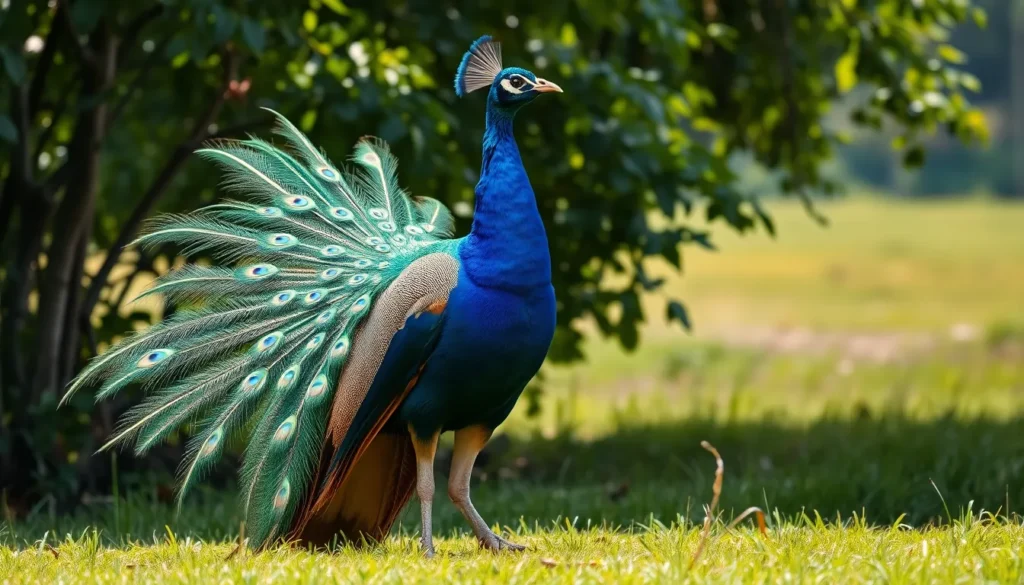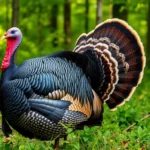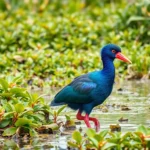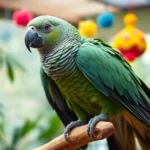Few birds capture our imagination quite like the magnificent peacock. With their spectacular tail feathers that shimmer in brilliant blues and greens, these stunning creatures have fascinated humans for thousands of years. We’ve seen them grace royal gardens, inspire countless works of art, and serve as symbols of beauty and pride across cultures worldwide.
But there’s so much more to peacocks than their breathtaking plumage. These remarkable birds possess complex social behaviors, incredible intelligence, and surprising adaptability that makes them truly extraordinary members of the animal kingdom. From their distinctive calls that can be heard for miles to their elaborate courtship rituals, peacocks continue to amaze researchers and bird enthusiasts alike.
Whether you’re curious about their natural habitat, wondering about their role in different cultures, or simply want to learn more about these captivating creatures, we’re here to reveal the intriguing area of peacocks and discover what makes them one of nature’s most spectacular birds.
What Is a Peacock Bird?
Peacocks are large, colorful birds belonging to the pheasant family Phasianidae. These magnificent creatures showcase some of nature’s most spectacular plumage displays and represent one of the most recognizable bird species worldwide.
Physical Characteristics and Appearance
Size and Build
Peacocks measure between 3 to 5 feet in body length with males weighing 9 to 13 pounds. Females typically weigh 6 to 9 pounds and appear smaller in overall stature. Their long necks and legs give them an elegant posture that enhances their regal appearance.
Distinctive Features
The most striking feature includes their elaborate tail feathers called a train. Males display up to 200 iridescent eye spots known as ocelli across their train feathers. Each ocelli contains brilliant blues, greens, and bronze colors that shimmer in sunlight.
Coloration Patterns
Their neck and breast feathers showcase deep blue and green metallic hues. Wing feathers display intricate patterns of black, brown, and iridescent blue markings. The head features a crown of short feathers that can be raised during displays.
Male vs Female Peacocks
Male Peacocks (Peafowl)
Males possess the famous ornate tail train extending 4 to 5 feet beyond their body. They exhibit vibrant blue and green plumage across their neck and chest areas. Males use their spectacular tail displays during mating rituals to attract females.
Female Peacocks (Peahens)
Females display more subdued brown and gray coloring with subtle green highlights on their necks. Peahens lack the elaborate tail train that males possess. Their smaller size and muted colors provide better camouflage while nesting and caring for young.
Behavioral Differences
Males perform elaborate courtship dances involving tail fanning and strutting movements. Females focus on nest building and chick rearing responsibilities. Males often compete with other males for territory and mating rights during breeding season.
Peacock Bird Species and Varieties
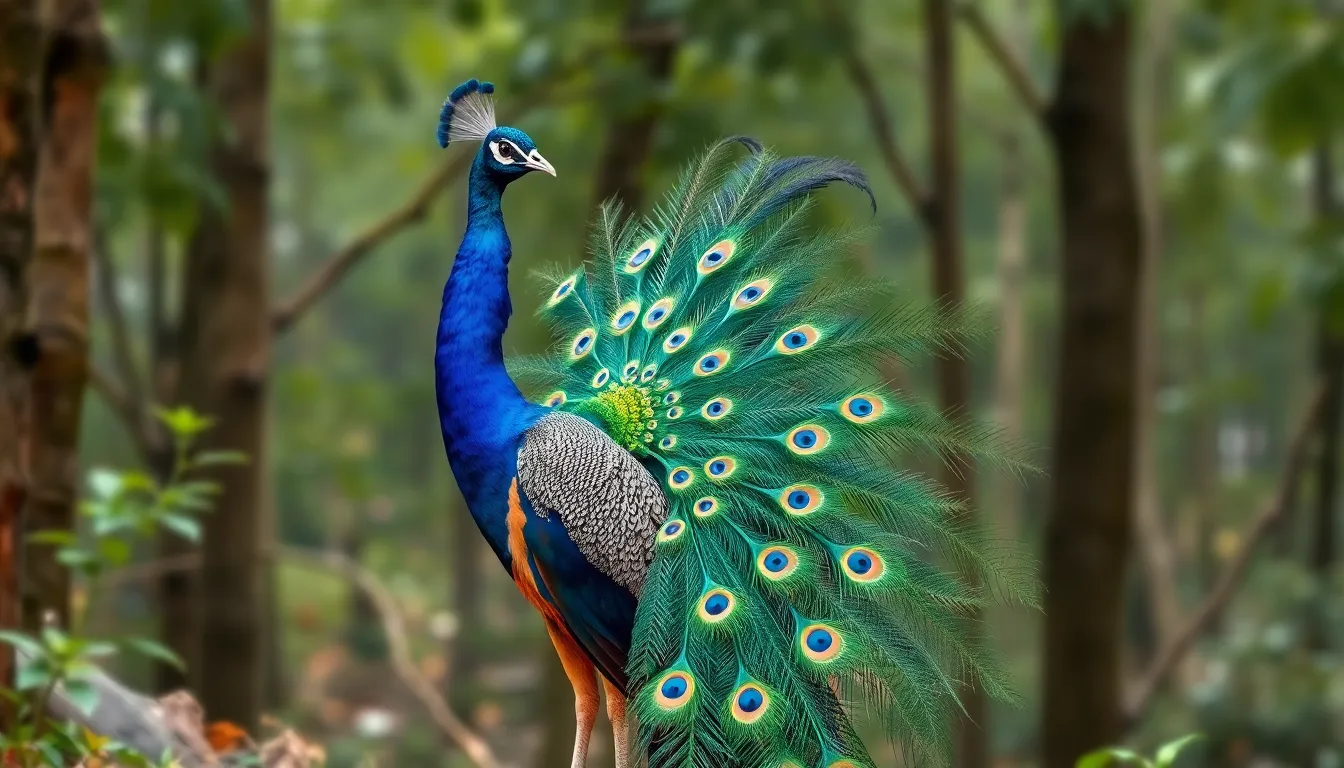
Three distinct peacock species exist across different continents, each displaying unique characteristics and adaptations to their exact environments. These magnificent birds represent diverse evolutionary paths while maintaining the signature beauty that defines the peacock family.
Indian Peacock
Indian peacocks (Pavo cristatus) stand as the most recognizable peacock species worldwide. We find these birds naturally distributed across the Indian subcontinent, including India, Pakistan, Sri Lanka, and Bangladesh. Males showcase the most vibrant blue and green plumage with their iconic fan-shaped tail display featuring up to 200 ocelli or eye spots. The species measures 39 to 45 inches in body length, with males reaching weights between 9 to 13 pounds. Females display more subdued brown and gray coloring with shorter tails, measuring approximately 37 inches in length. These peacocks inhabit deciduous forests, grasslands, and cultivated areas at elevations up to 6,000 feet. India designated this species as their national bird in 1963, recognizing its cultural significance and natural heritage value.
Green Peacock
Green peacocks (Pavo muticus) inhabit Southeast Asian regions including Myanmar, Thailand, Cambodia, Laos, Vietnam, Malaysia, and Java. Males exhibit predominantly green and bronze plumage with less blue coloration compared to their Indian counterparts. We observe that green peacocks display taller crests and longer legs, with males reaching lengths of 71 to 118 inches including their train. The species shows more pronounced sexual dimorphism, with females displaying greener necks and more prominent wing markings than Indian peahens. Green peacocks prefer tropical forests near water sources and demonstrate stronger flight capabilities than other peacock species. Conservation status remains vulnerable due to habitat loss and hunting pressure across their native range. These birds produce distinctly different calls with higher pitched vocalizations compared to Indian peacocks.
Congo Peacock
Congo peacocks (Afropavo congensis) represent the only African peacock species and the most recently discovered among the three varieties. We encounter these birds exclusively in the dense rainforests of the Democratic Republic of Congo. Males display deep blue and green metallic plumage without the elaborate tail fan characteristic of Asian peacock species. The species measures 24 to 28 inches in length, making them significantly smaller than their Asian relatives. Females show similar coloring to males but with less iridescent qualities and slightly smaller proportions. Congo peacocks possess shorter tails and lack the ornate eye spots found on Indian and green peacock trains. Scientists first described this species in 1936, making it the last peacock species identified by researchers. These birds inhabit primary and secondary forest floors at elevations between 1,600 and 4,100 feet, maintaining secretive behaviors that make field observations challenging.
Natural Habitat and Distribution
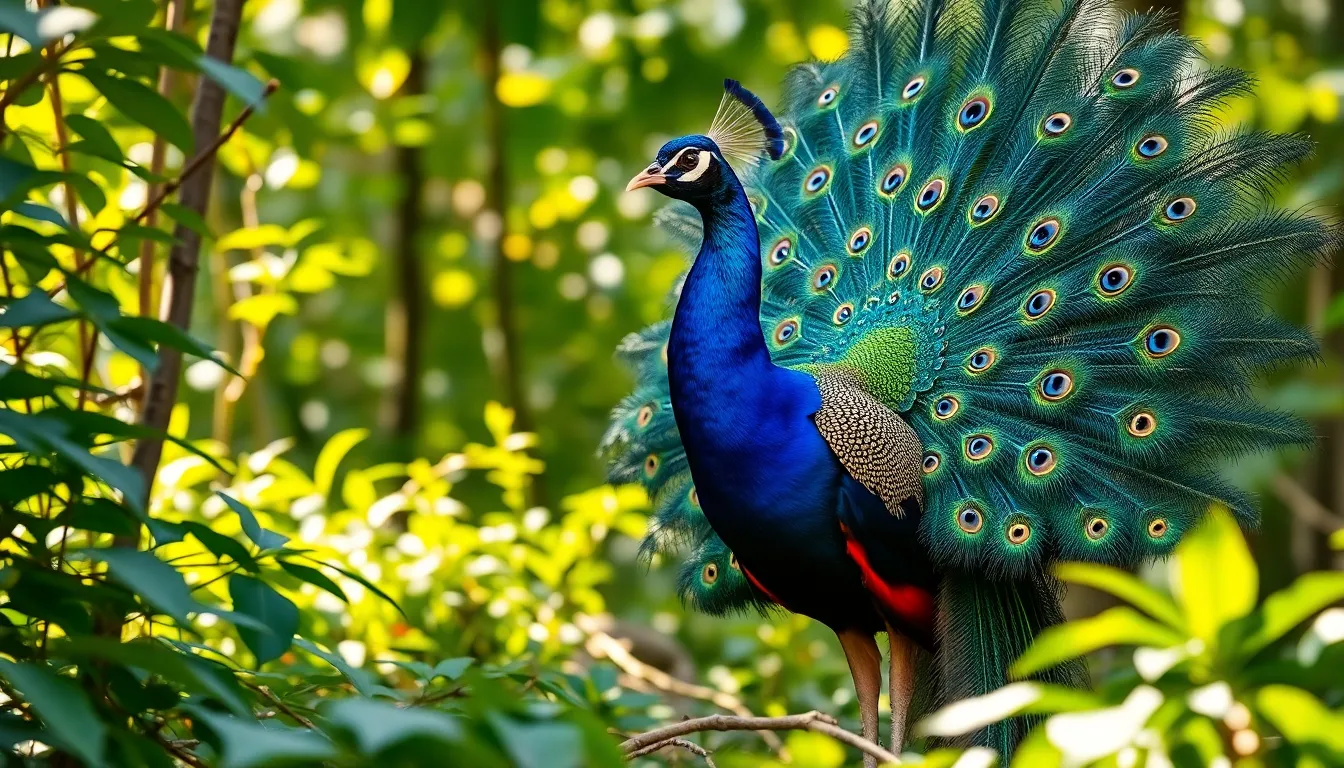
Peacocks inhabit diverse ecosystems across Asia and Africa, adapting to various environmental conditions that support their complex behavioral needs. Understanding their natural distribution patterns reveals how these magnificent birds thrive in exact geographical regions.
Where Peacocks Live in the Wild
Indian peacocks occupy the Indian subcontinent, ranging from Pakistan through India and extending into Sri Lanka. These birds establish territories in the Western Ghats, central Indian forests, and the Himalayan foothills up to 6,000 feet elevation. We observe wild populations flourishing in Rajasthan’s arid regions, Kerala’s tropical landscapes, and Uttarakhand’s mountainous terrain.
Green peacocks inhabit Southeast Asian countries including Myanmar, Thailand, Laos, Cambodia, Vietnam, and Indonesia’s Java island. Their populations concentrate in Myanmar’s central dry zone, Thailand’s protected national parks, and Java’s remaining forest fragments. Malaysia and southern China host smaller populations that face increasing habitat pressure from human development.
Congo peacocks live exclusively in the Democratic Republic of Congo’s dense rainforest regions. These African peacocks occupy the Congo Basin’s primary and secondary forests, particularly in the Ituri Forest and surrounding areas. Their distribution remains limited to central Africa’s tropical rainforest belt, making them the most geographically restricted peacock species.
Habitat Requirements and Preferences
Peacocks require mixed habitats that combine dense forest cover with open grasslands for optimal survival. Forest areas provide essential roosting sites in tall trees, protection from predators, and nesting locations for females. Open grasslands and agricultural edges offer foraging opportunities where peacocks search for insects, small reptiles, seeds, and fruits.
Water sources play a critical role in peacock habitat selection, with birds typically establishing territories within 3 miles of reliable water supplies. Rivers, streams, ponds, and seasonal water bodies support both drinking needs and the diverse prey species that peacocks consume. Agricultural areas near forests create ideal habitat mosaics that peacocks exploit for food while maintaining access to protective tree cover.
Elevation preferences vary among species, with Indian peacocks adapting to altitudes from sea level to 6,000 feet. Temperature ranges between 68°F and 95°F support year-round peacock activity, though birds demonstrate remarkable adaptability to seasonal variations. Rainfall patterns influence habitat quality, with annual precipitation between 20 and 80 inches supporting the vegetation diversity that sustains peacock populations.
| Species | Geographic Range | Preferred Elevation | Annual Rainfall |
|---|---|---|---|
| Indian Peacock | Indian subcontinent, Sri Lanka | Sea level to 6,000 feet | 20-80 inches |
| Green Peacock | Southeast Asia, Java | Sea level to 3,000 feet | 40-100 inches |
| Congo Peacock | Democratic Republic of Congo | 1,500-4,000 feet | 60-80 inches |
Peacock Bird Behavior and Social Structure
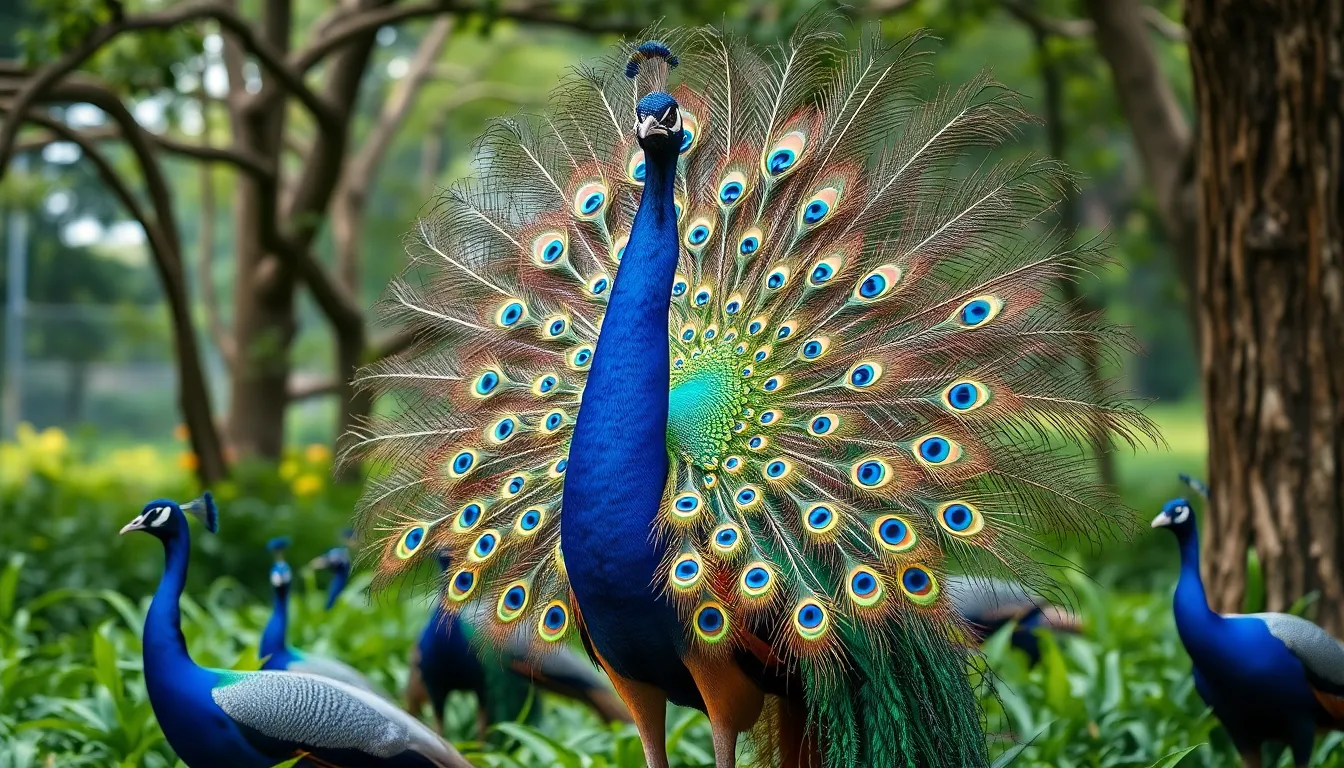
Peacock behavior encompasses complex social dynamics that govern their interactions within groups and territorial boundaries. These magnificent birds demonstrate sophisticated behavioral patterns that vary significantly between mating seasons and daily survival activities.
Mating Rituals and Courtship Display
Male peacocks perform elaborate courtship displays to attract potential mates during breeding season from April to August. The iconic tail fan display involves spreading their 200 iridescent eye spots in a semicircular formation while vibrating the feathers to create a rustling sound that females can hear from distances up to 1 mile away.
Courtship behavior includes exact ritualized movements where males position themselves 6 to 8 feet from females while performing the fan display. They emit loud calls reaching 115 decibels and execute a backward walking dance while maintaining direct eye contact with peahens. Males also engage in wing shaking displays and head bobbing motions to demonstrate their fitness and genetic quality.
Territorial competition between males intensifies during mating season as they establish dominance hierarchies. Dominant males control territories spanning 2 to 4 acres and may mate with 2 to 5 females within their established range. Subordinate males often form bachelor groups and employ alternative mating strategies like satellite behavior near dominant male territories.
Daily Activities and Feeding Habits
Peacocks exhibit crepuscular behavior patterns with peak activity occurring during dawn and dusk hours between 5:30 AM to 8:00 AM and 4:00 PM to 7:30 PM. They spend approximately 60% of their waking hours foraging for food across their territory while maintaining constant vigilance for predators.
Foraging behavior involves systematic ground scratching using their strong claws to uncover insects like beetles termites and ants which comprise 40% of their diet. They consume plant matter including seeds berries leaves and flowers that constitute the remaining 60% of their nutritional intake. Peacocks require 1.5 to 2.5 pounds of food daily and can travel distances up to 3 miles while foraging.
Roosting behavior begins 30 minutes before sunset when peacocks gather in groups of 8 to 15 individuals at elevated perches 15 to 25 feet above ground. They prefer large tree branches or tall structures that provide protection from ground predators like leopards and wild dogs. Social grooming occurs during midday rest periods when peacocks engage in mutual preening to maintain feather condition and strengthen social bonds within their flock structure.
Diet and Feeding Patterns
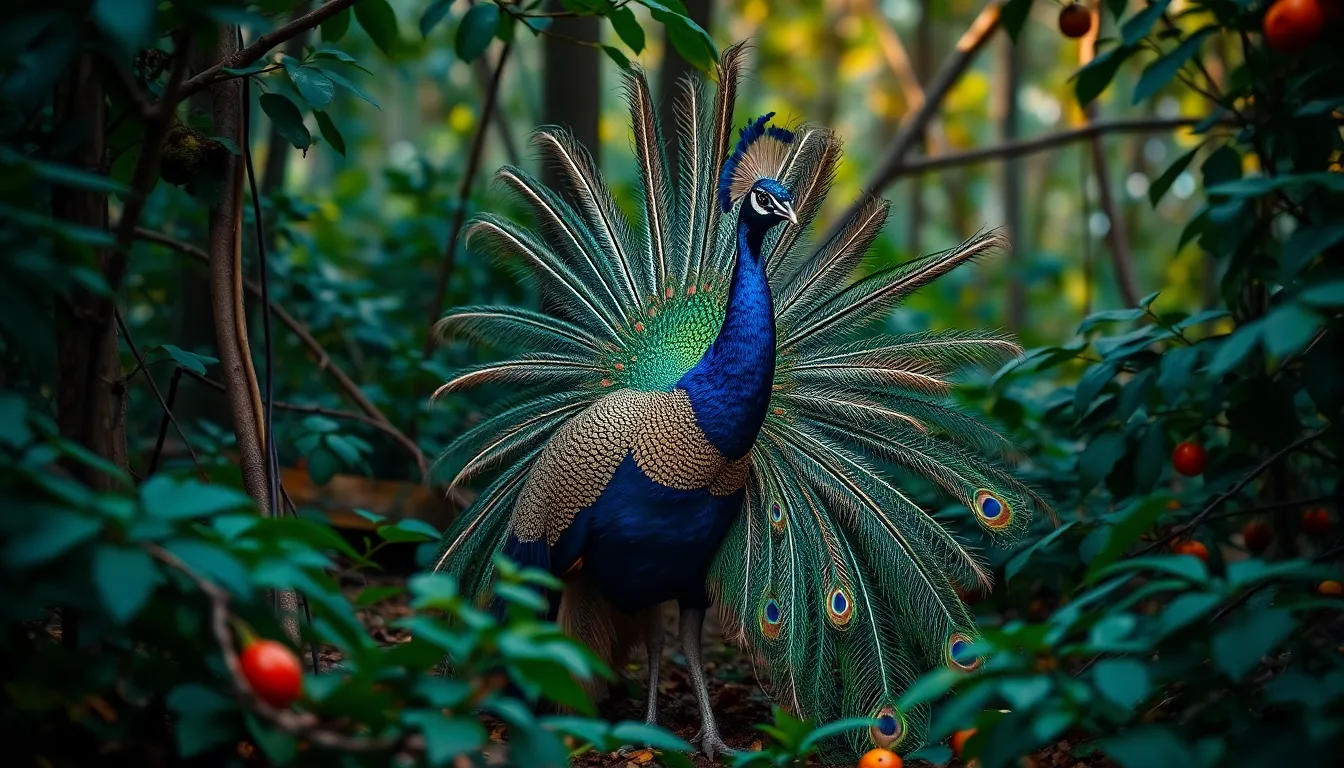
Peacocks consume a diverse omnivorous diet that varies significantly based on seasonal availability and habitat conditions. Their feeding patterns reflect opportunistic foraging behavior, with these magnificent birds actively searching for food during dawn and dusk hours when prey activity peaks.
Primary Food Sources
| Food Category | Exact Items | Percentage of Diet |
|---|---|---|
| Insects | Beetles, ants, termites, crickets | 40-50% |
| Plant Matter | Seeds, fruits, flowers, leaves | 30-35% |
| Small Animals | Lizards, frogs, small snakes | 10-15% |
| Grains | Wild grasses, cultivated crops | 5-10% |
Insects form the cornerstone of peacock nutrition, providing essential proteins required for feather development and overall health. Beetles represent their most frequently consumed insect prey, followed by various ant species that peacocks locate by scratching through leaf litter and soil. Termites become particularly important during monsoon seasons when these insects swarm in large numbers.
Foraging Behavior and Techniques
Ground foraging dominates peacock feeding behavior, with birds using their strong legs to scratch through debris and uncover hidden prey. They employ a distinctive head tilting motion to examine potential food items closely before consumption. Peacocks demonstrate remarkable visual acuity when hunting, spotting small insects from distances exceeding 10 feet.
Tree foraging occurs less frequently but becomes more common during fruit ripening seasons. Indian peacocks show particular preference for figs, berries, and tender shoots found in their forest habitats. Green peacocks exhibit similar arboreal feeding patterns but tend to consume more bamboo shoots and forest fruits compared to their Indian counterparts.
Seasonal Dietary Variations
Monsoon periods dramatically increase insect availability, allowing peacocks to consume up to 70% more protein rich foods during these months. Breeding males require additional nutrition to maintain their elaborate plumage and sustain energy intensive courtship displays. Females increase their protein intake by 30% during egg laying periods to support proper embryo development.
Dry seasons force dietary adaptations as insect populations decline significantly. Peacocks shift toward consuming more seeds, dried fruits, and available vegetation during these challenging periods. Water source proximity becomes critical during dry months, as peacocks require daily access to fresh water for both drinking and food processing.
Feeding Schedule and Social Dynamics
Early morning foraging sessions typically last 2 to 3 hours, beginning approximately 30 minutes before sunrise. Evening feeding periods begin around 4 PM and continue until darkness falls completely. Midday hours find peacocks resting in shaded areas, avoiding the intense heat that reduces prey activity.
Social feeding hierarchies emerge within peacock flocks, with dominant males accessing premium foraging locations first. Females and younger birds often follow established feeding trails created by dominant individuals. Territorial males defend productive feeding areas during breeding seasons, restricting access to subordinate flock members.
Peacock Bird as Pets
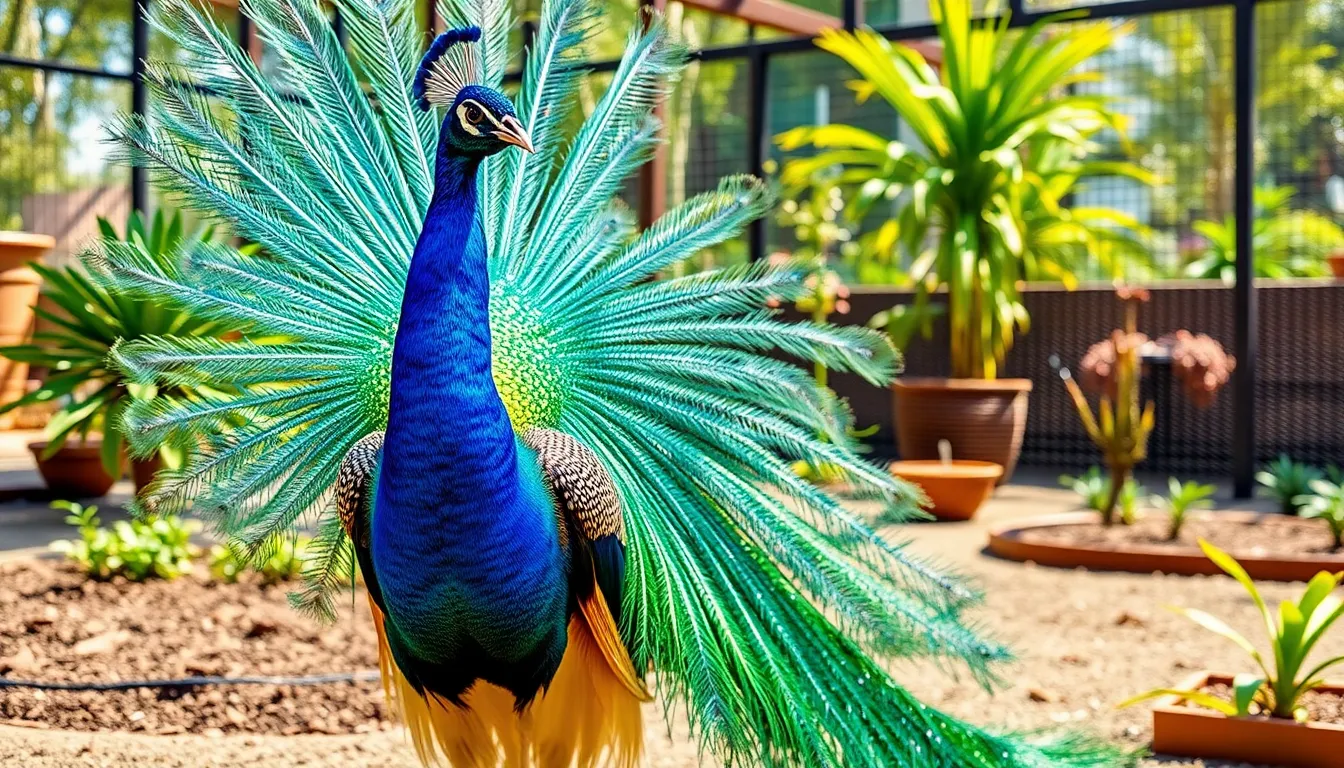
Peacock ownership presents unique challenges that extend beyond typical avian care requirements. These magnificent birds demand specialized attention that differs significantly from their wild behavioral patterns discussed earlier.
Legal Considerations and Permits
Most states require permits for peacock ownership due to their classification as exotic birds. Federal regulations under the Lacey Act govern interstate transport and commerce of these pheasants. Local ordinances often restrict peacock keeping in residential areas because of noise concerns and space requirements.
State wildlife departments issue permits ranging from $50 to $500 annually depending on jurisdiction. Documentation includes veterinary health certificates, facility inspections, and proof of adequate housing space. Some municipalities prohibit peacock ownership entirely in urban zones due to their loud vocalizations that can exceed 100 decibels.
Import permits become necessary when acquiring peacocks from other countries. CITES regulations protect wild populations and require documentation proving captive breeding origins. Registration with USDA becomes mandatory for commercial breeding operations or facilities housing more than 3 peacocks.
Care Requirements and Challenges
Housing peacocks requires minimum enclosure dimensions of 80 square feet per bird with heights exceeding 8 feet to accommodate their flight capabilities. Secure roofing prevents escapes while providing protection from aerial predators. These birds cannot tolerate temperatures below 20°F without heated shelters.
Daily feeding costs range from $15 to $25 per bird using specialized game bird feed supplemented with fruits and vegetables. Fresh water sources require daily cleaning due to peacocks’ bathing behaviors. Veterinary care presents challenges since few exotic animal specialists understand peacock medicine, with consultation fees starting at $200.
Social isolation causes stress in single peacocks since they maintain complex flock hierarchies in nature. Breeding pairs produce 4 to 8 eggs annually requiring incubation periods of 28 days. Chick mortality rates reach 30% during the first month without proper brooding conditions.
Noise management becomes the primary challenge for urban peacock owners. Males vocalize most intensively during breeding seasons from March through August. These calls carry over distances of 1 mile and occur throughout daylight hours. Property damage includes scratching painted surfaces, destroying garden plants, and aggressive territorial behaviors toward reflective objects.
Cultural Significance and Symbolism

Peacocks represent divine beauty and spiritual awakening across many cultures, with their iridescent plumage symbolizing immortality and renewal in ancient mythologies. Hindu traditions regard the peacock as sacred to Lord Krishna and Goddess Saraswati, while the bird serves as the national symbol of India, appearing on currency and government emblems. Buddhist teachings associate peacocks with compassion and vigilance, as these birds consume poisonous snakes yet remain unharmed, representing the transformation of negative emotions into wisdom.
Christianity adopted peacock symbolism during the Byzantine period, where the bird’s molting and regrowth cycle represented resurrection and eternal life. Medieval European art frequently depicted peacocks in religious contexts, particularly in manuscripts and church decorations. Greek mythology connected peacocks to Hera, queen of the gods, who placed the hundred eyes of Argus onto the bird’s tail feathers as symbols of watchfulness and protection.
Persian and Islamic cultures view peacocks as guardians of paradise, with their elaborate displays representing divine glory and celestial beauty. Chinese feng shui practitioners consider peacock feathers powerful symbols of good fortune, beauty, and prosperity when displayed in homes. Japanese art traditions incorporate peacock motifs in textiles and ceramics, where the birds symbolize elegance and refinement.
Ancient Egyptian civilizations associated peacocks with the sun god Ra, believing their tail feathers represented the all-seeing eyes of divine providence. Roman nobility kept peacocks as status symbols, serving them at elaborate banquets to demonstrate wealth and luxury. Modern Western cultures continue to use peacock imagery in fashion, architecture, and decorative arts, where the bird represents pride, confidence, and artistic expression.
| Culture | Symbolism | Exact Meaning |
|---|---|---|
| Hindu | Sacred | Divine beauty, Lord Krishna |
| Buddhist | Transformation | Converting poison to wisdom |
| Christian | Resurrection | Eternal life, renewal |
| Greek | Protection | Divine watchfulness |
| Persian | Paradise | Celestial glory |
| Chinese | Fortune | Prosperity, beauty |
| Japanese | Refinement | Elegance, artistic beauty |
| Egyptian | Divinity | All-seeing providence |
Contemporary peacock symbolism extends into psychology and personal development, where the bird represents self-confidence, authentic expression, and the courage to display one’s true colors. Corporate branding frequently incorporates peacock imagery to convey luxury, quality, and attention to detail. Wedding traditions in various cultures include peacock feathers as symbols of eternal love and faithful partnership, while interior designers use peacock colors and patterns to create spaces that evoke opulence and sophistication.
Conservation Status and Threats
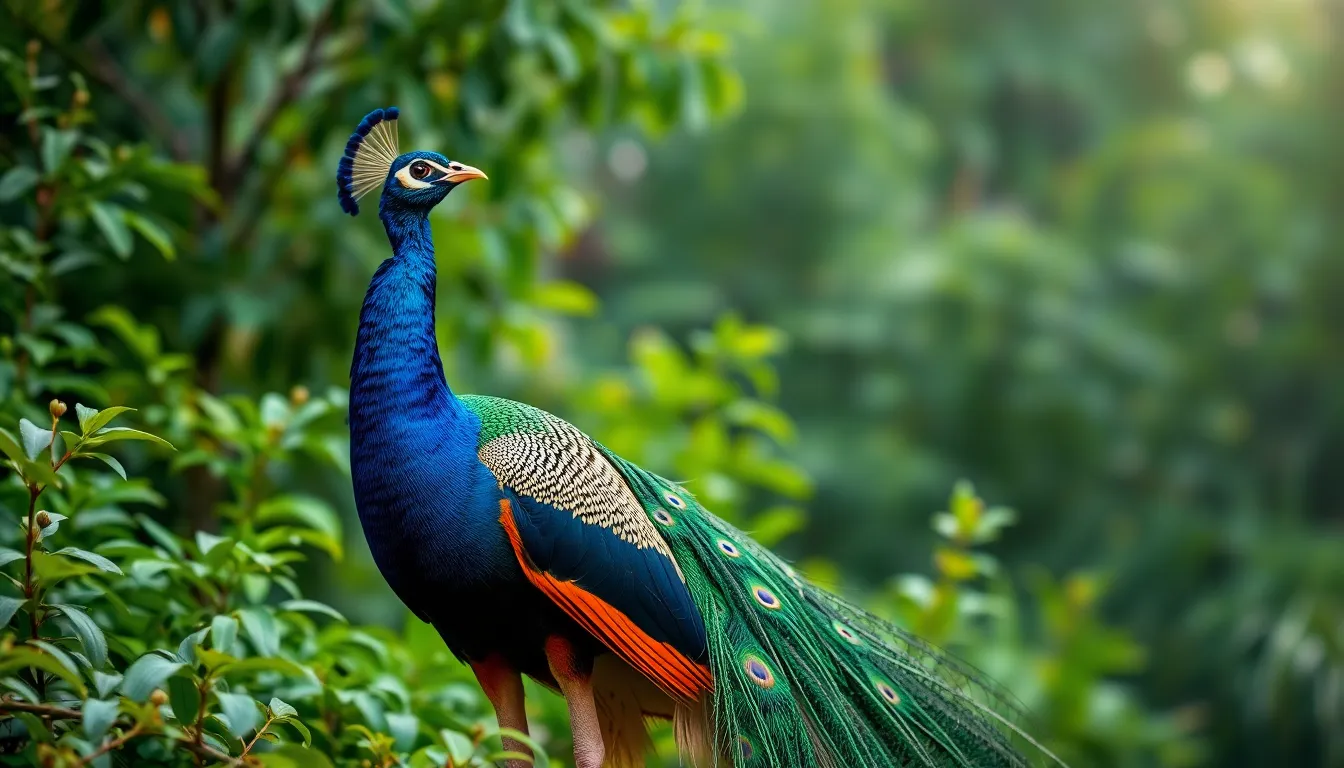
Conservation efforts for peacock species vary significantly across their geographic ranges, with each species facing distinct challenges that threaten their long-term survival. The International Union for Conservation of Nature (IUCN) classifies the Indian Peacock as “Least Concern” due to stable population numbers exceeding 100,000 individuals across the Indian subcontinent. Green Peacocks face more serious conservation challenges, earning an “Endangered” status with fewer than 15,000-30,000 individuals remaining in fragmented populations throughout Southeast Asia.
Congo Peacocks represent the most vulnerable species, classified as “Vulnerable” with an estimated population of 2,500-10,000 birds confined to the dense rainforests of the Democratic Republic of Congo. Habitat destruction poses the primary threat to all peacock species, with deforestation rates in Southeast Asia reaching 1.2% annually and directly impacting Green Peacock territories. Agricultural expansion eliminates crucial foraging areas and nesting sites, forcing peacock populations into smaller, isolated patches of suitable habitat.
| Species | IUCN Status | Population Estimate | Primary Threats |
|---|---|---|---|
| Indian Peacock | Least Concern | 100,000+ | Habitat fragmentation, hunting |
| Green Peacock | Endangered | 15,000-30,000 | Deforestation, illegal trade |
| Congo Peacock | Vulnerable | 2,500-10,000 | Mining, civil unrest |
Human encroachment accelerates habitat fragmentation, creating barriers that prevent genetic exchange between isolated populations. Mining operations in the Democratic Republic of Congo destroy approximately 400 square kilometers of peacock habitat annually, while palm oil plantations in Southeast Asia eliminate critical Green Peacock territories. Illegal hunting pressures increase during economic hardships, with peacock feathers and meat commanding high prices in black markets across Asia and Africa.
Climate change compounds existing conservation challenges by altering rainfall patterns and temperature ranges that peacocks depend on for breeding and foraging success. Rising temperatures force peacock populations to higher elevations, reducing available habitat and increasing competition for resources. Extreme weather events, including prolonged droughts and severe monsoons, disrupt traditional breeding cycles and reduce reproductive success rates by 15-25% in affected regions.
Disease transmission from domestic poultry threatens wild peacock populations, particularly in areas where farming operations overlap with natural habitats. Avian influenza outbreaks can devastate local peacock populations that lack immunity to introduced pathogens. Captive breeding programs in India, Thailand, and the Democratic Republic of Congo work to maintain genetic diversity and supplement wild populations through careful reintroduction efforts.
Protected areas provide essential refuges for peacock populations, with national parks in India safeguarding over 60% of the country’s peacock habitat. Community conservation initiatives in Southeast Asia engage local populations in protecting Green Peacock territories through sustainable ecotourism programs. Research stations monitor peacock population dynamics and breeding success, providing crucial data for adaptive management strategies that respond to changing environmental conditions.
Conclusion
We’ve discovered that peacocks represent far more than just ornamental beauty in our natural industry. These magnificent birds showcase remarkable intelligence adaptability and complex social structures that continue to fascinate researchers and bird enthusiasts alike.
Their enduring presence in human culture speaks to something deeper than mere aesthetic appreciation. From ancient mythologies to modern conservation efforts peacocks remind us of our responsibility to protect the diverse species that share our planet.
As we move forward it’s clear that understanding and preserving these extraordinary creatures requires both scientific knowledge and cultural appreciation. Whether we encounter them in their natural habitats or admire them from afar peacocks will undoubtedly continue inspiring wonder for generations to come.
Frequently Asked Questions
What are the main physical differences between male and female peacocks?
Male peacocks are significantly larger, measuring 3-5 feet in length and weighing 9-13 pounds. They display spectacular iridescent plumage with elaborate tail feathers (trains) featuring up to 200 eye spots. Female peahens are smaller with more subdued, camouflaged coloring that helps protect them while nesting and raising chicks.
How many species of peacocks exist and where are they found?
There are three distinct peacock species: the Indian Peacock (Pavo cristatus) found in the Indian subcontinent, the Green Peacock (Pavo muticus) inhabiting Southeast Asia, and the Congo Peacock (Afropavo congensis) native to the Democratic Republic of Congo’s rainforests. Each species has adapted to different geographic regions and environmental conditions.
What type of habitat do peacocks prefer?
Peacocks thrive in mixed habitats combining dense forest cover with open grasslands. They require areas near reliable water sources and adapt well to diverse ecosystems across Asia and Africa. Their preferred environments include woodland edges, agricultural areas, and regions with varying elevations depending on the species.
What do peacocks eat and how do they find food?
Peacocks are omnivorous with insects comprising 40-50% of their diet, supplemented by plant matter, small animals, and grains. They primarily forage on the ground during dawn and dusk, using their excellent visual acuity to locate food. Their diet varies seasonally based on food availability in their habitat.
Can peacocks be kept as pets legally?
Most states require permits for peacock ownership since they’re classified as exotic birds. Legal requirements include proper housing, specialized veterinary care, and compliance with transport regulations. Potential owners must consider their social needs, noise levels during breeding seasons, and significant care costs before acquiring these birds.
What is the cultural significance of peacocks?
Peacocks symbolize divine beauty, spiritual awakening, and immortality across various cultures. In Hindu traditions, they’re sacred to Lord Krishna and Goddess Saraswati. Christianity associates them with resurrection, while Greek mythology connects them to protection. Modern cultures use peacock imagery to represent luxury, beauty, and eternal love.
What is the conservation status of different peacock species?
Indian Peacocks are classified as “Least Concern” with stable populations. Green Peacocks are “Endangered” with fewer than 30,000 individuals remaining due to habitat destruction. Congo Peacocks are “Vulnerable” with only 2,500-10,000 estimated individuals, facing threats from mining activities and civil unrest in their native regions.
How do peacocks behave during mating season?
Male peacocks perform elaborate courtship displays by spreading their tail feathers and engaging in ritualized movements to attract females. They establish territorial dominance and compete with other males. These displays showcase their vibrant plumage and demonstrate their fitness to potential mates through complex social behaviors.

